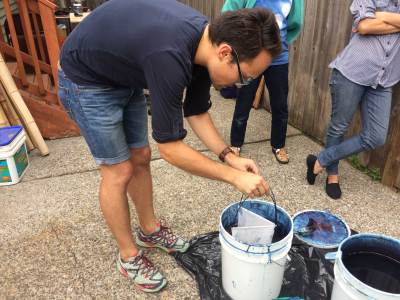Last Saturday we held the Katzome workshop with Tyler Peterson, textile artist. It was a cloudy overcast day which was a relief from the triple digit weather we have had over the past week. After Tyler introduced himself he talked about how katazome (stencil resist ) is used in kimono and other clothing. He showed us some photos of his work
We talked about making the resist paste with recipes and sources, and then we got to work hands on by helping him make a batch of paste. The ingredients were mixed and formed into a doughnut shape and put in a steamer to cook. While the paste was steaming, we took a look at some historical stencils, modern adaptations of stencils, books of stencils and Japanese motifs.



 Tyler then gave us the opportunity to draw and then cut our own stencil designs using mylar and x-acto knives. Everyone had a chance to show their creativity. Big, bold, or cute or delicate, traditional or modern. While we were working on our designs and stencils, the paste was cooked and Tyler showed us how to add the other ingredients and and using the suribachi (Japanese mortar and pestle) to grind the paste and incorporate the ingredients and finally thin it to a good consistency.
Tyler then gave us the opportunity to draw and then cut our own stencil designs using mylar and x-acto knives. Everyone had a chance to show their creativity. Big, bold, or cute or delicate, traditional or modern. While we were working on our designs and stencils, the paste was cooked and Tyler showed us how to add the other ingredients and and using the suribachi (Japanese mortar and pestle) to grind the paste and incorporate the ingredients and finally thin it to a good consistency.

When the paste was ready he showed us how to squeegee the paste through the stencil so that the patter came out on the cloth.

 We hung the cloth to dry the paste. Meanwhile, Tyler talked with us about indigo dyeing. He had two vats, one natural indigo and synthetic. Keeping a vat going means feeding and caring for it. Things that I did not know about is that indigo is the only natural vegetable source of blue color, and that the dye lays on top of the cloth, not penetrates into it. So you can layer indigo through several dippings to get darker colors. Also like blue jeans and denim the color can also flake off and run.
We hung the cloth to dry the paste. Meanwhile, Tyler talked with us about indigo dyeing. He had two vats, one natural indigo and synthetic. Keeping a vat going means feeding and caring for it. Things that I did not know about is that indigo is the only natural vegetable source of blue color, and that the dye lays on top of the cloth, not penetrates into it. So you can layer indigo through several dippings to get darker colors. Also like blue jeans and denim the color can also flake off and run. 
 When indigo comes out of the dye vat, it is this greenish color but we dipped it in water to reduce the oxygen it turns that beautiful brilliant blue. Subsequent dippings can make it darker and longer times in the vat you also can get ombré effects by how slowly you dip and take out the cloth. To dip the cloth without gloves, we used these thin bamboo sticks that have a needle in each end. The bamboo is flexible so you can bend them and attach them with the needles to make handles to dip the cloth.
When indigo comes out of the dye vat, it is this greenish color but we dipped it in water to reduce the oxygen it turns that beautiful brilliant blue. Subsequent dippings can make it darker and longer times in the vat you also can get ombré effects by how slowly you dip and take out the cloth. To dip the cloth without gloves, we used these thin bamboo sticks that have a needle in each end. The bamboo is flexible so you can bend them and attach them with the needles to make handles to dip the cloth.





 Again, the cloth comes out green, but dip it in the water and it gradually turns blue. Magic!
Again, the cloth comes out green, but dip it in the water and it gradually turns blue. Magic!
When the stenciled paste was dry we got to try our own hand at making handles, and dyeing. 



 Once the cloth is dry, you can soak it in hot water to remove the paste. Here is my finished piece. I wonder what I can make with it — a handbag?
Once the cloth is dry, you can soak it in hot water to remove the paste. Here is my finished piece. I wonder what I can make with it — a handbag?








